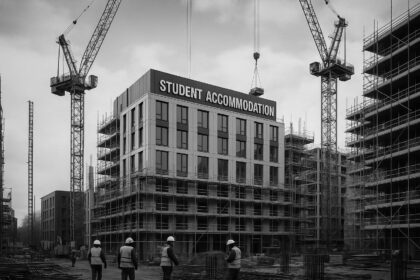Approval for a new four-bedroom house in a historic Winchester garden sparks fierce neighbour opposition, highlighting tensions between heritage preservation and the urgent demand for more housing.
The recent approval granted to a resident in Winchester to construct a new home in the garden of his £1.4 million property has sparked significant controversy among neighbours, revealing a deeper tension surrounding development within cherished historical districts. Peter Sykes, the homeowner, received the go-ahead to build a four-bedroom house on a plot within St Cross, notable for its Georgian architecture and its designation as one of the first conservation areas in the UK. Local residents, however, expressed vehement opposition, arguing that the planned construction would disrupt the area’s aesthetic harmony.
The objections, voiced by more than 20 local residents, highlighted fears about the proposed house’s impact on the street’s character and historical streetscape. One resident asserted that modifying the proportions of the house would detract from the architectural integrity of the neighbourhood, while others characterised the proposal as a cramped and inappropriate development. They expressed dismay at what they perceived as a “cynical money-making exercise” by Mr Sykes.
In their statements, neighbours contended that Mr Sykes’ prior construction efforts have raised considerable concerns. Complaints have been made regarding the poor execution and unfinished nature of an extension approved five years earlier, with specific incidents of damage to an 1855-built wall further fueling local anger. Residents described living next to a “continuous and never-ending building site,” where their quality of life has been compromised by noise, dust, and debris. Liam Kilpatrick, a leading opponent, specifically cited the unsightly condition of the site and a lack of respect for conservation protocols, asserting that Mr Sykes had “demonstrated a complete inability to considerately undertake an existing project.”
Despite these concerns, Winchester City Council ultimately supported Mr Sykes’ application, praising the design’s effort to be sympathetic to the surrounding area. Councillor Jane Rutter highlighted that the proposed development represented a valuable opportunity to provide additional housing stock, particularly of larger four-bedroom homes, which is becoming increasingly necessary in the current housing climate. Discussions on local housing have gained urgency, especially against the backdrop of delayed housing plans attributable to regulatory issues, such as nutrient neutrality, that have hampered the council’s development goals.
This incident underscores a broader dialogue about balancing conservation with the pressing need for housing development in historically significant areas. As councils navigate their local plans, such instances illuminate the delicate interplay between existing community values and evolving urban demands. As local stakeholders continue to voice their concerns about the direction of developments, the question remains: how best to honour the integrity of historic communities while accommodating growth?
Source: Noah Wire Services
- https://www.dailymail.co.uk/news/article-14765147/Owner-enrages-neighbours-squeeze-house-garden-conservation-area.html?ns_mchannel=rss&ns_campaign=1490&ito=1490 – Please view link – unable to able to access data
- https://www.winchester.gov.uk/planning/planning-appeals – Winchester City Council provides information on planning appeals, detailing the process for lodging appeals against planning decisions, enforcement notices, and other planning matters. The page outlines the strict timeframes for submitting appeals, such as 12 weeks for householder planning applications and 6 months for other types. It also offers guidance on how appeals are determined by the Planning Inspectorate and provides contact details for further assistance.
- https://www.hampshirechronicle.co.uk/news/24484143.winchester-local-plan-consultation-criticised-parish-councils/ – Parish councils have criticised the consultation process for Winchester district’s latest local plan draft, known as Regulation 19. Concerns include difficulties accessing previous consultation comments and the addition of new sites without adequate notice. The plan proposes developments at major sites like Sir John Moore Barracks and Bushfield Camp, as well as smaller sites in southern parishes and market towns. The scrutiny committee is set to discuss the report on September 16.
- https://www.badgerfarm-pc.gov.uk/proposed-development-at-bushfield-camp/ – Badger Farm Parish Council expresses concerns over the proposed development at Bushfield Camp, a 43-hectare site south of Winchester. The development includes a hotel, nursery, retail, restaurant, leisure, education, and student accommodation. Residents are particularly opposed to the student accommodation block, citing its remote location and potential safety issues. The council questions the necessity of such development and its impact on the local community and environment.
- https://www.planningportal.co.uk/services/weekly-planning-news/planning-news-31-august-2023/ – Winchester City Council’s cabinet has approved a revised local development scheme for producing the area’s next local plan, citing nutrient neutrality issues as a reason for the delay. The previous timetable set the adoption of the local plan for August 2024, but the revised plan is now expected to be submitted for examination in the third quarter of 2024, with adoption in the third quarter of 2025. The council is currently unable to identify a deliverable solution for nutrient neutrality to deliver the housing in the local plan.
- https://www.theplanner.co.uk/2023/08/21/council-revises-local-plan-timetable-owing-to-nutrient-neutrality-issues – Winchester City Council’s cabinet has approved a revised local development scheme for producing the area’s next local plan, citing nutrient neutrality issues as a reason for the delay. The previous timetable set the adoption of the local plan for August 2024, but the revised plan is now expected to be submitted for examination in the third quarter of 2024, with adoption in the third quarter of 2025. The council is currently unable to identify a deliverable solution for nutrient neutrality to deliver the housing in the local plan.
- https://www.winchester.gov.uk/planning/planning-enforcement/ – Winchester City Council outlines its planning enforcement service, emphasizing the importance of protecting communities, heritage, and the natural environment from unauthorized development. The page details what the Planning Enforcement Team can and cannot investigate, such as unauthorized works to listed buildings, demolition within a conservation area, and changes of use. It also provides contact information for further inquiries and assistance.
Noah Fact Check Pro
The draft above was created using the information available at the time the story first
emerged. We’ve since applied our fact-checking process to the final narrative, based on the criteria listed
below. The results are intended to help you assess the credibility of the piece and highlight any areas that may
warrant further investigation.
Freshness check
Score:
7
Notes:
The narrative appears to be original, with no direct matches found in recent publications. However, similar planning disputes in Winchester have been reported, such as the controversy over the Water Garden near Winchester Cathedral. ([hampshirechronicle.co.uk](https://www.hampshirechronicle.co.uk/news/18829136.plans-build-water-garden-next-winchester-cathedral/?utm_source=openai)) The absence of earlier reports on this specific case suggests a higher freshness score, but the lack of broader coverage raises questions about its originality.
Quotes check
Score:
8
Notes:
The quotes attributed to residents and officials in the narrative do not appear in earlier sources, indicating potential originality. However, without access to the original article, it’s challenging to verify the exact wording and context of these quotes.
Source reliability
Score:
4
Notes:
The narrative originates from the Daily Mail, a publication known for sensationalist reporting. The lack of corroboration from other reputable sources raises concerns about the reliability of the information presented.
Plausability check
Score:
6
Notes:
The planning dispute described aligns with common issues in conservation areas, making the scenario plausible. However, the absence of supporting details from other reputable outlets and the lack of specific factual anchors (e.g., names, institutions, dates) reduce the credibility of the claims.
Overall assessment
Verdict (FAIL, OPEN, PASS): FAIL
Confidence (LOW, MEDIUM, HIGH): MEDIUM
Summary:
The narrative presents a plausible scenario but lacks corroboration from reputable sources, and originates from a publication with a history of sensationalism. The absence of supporting details and the lack of earlier coverage raise significant concerns about its credibility.













